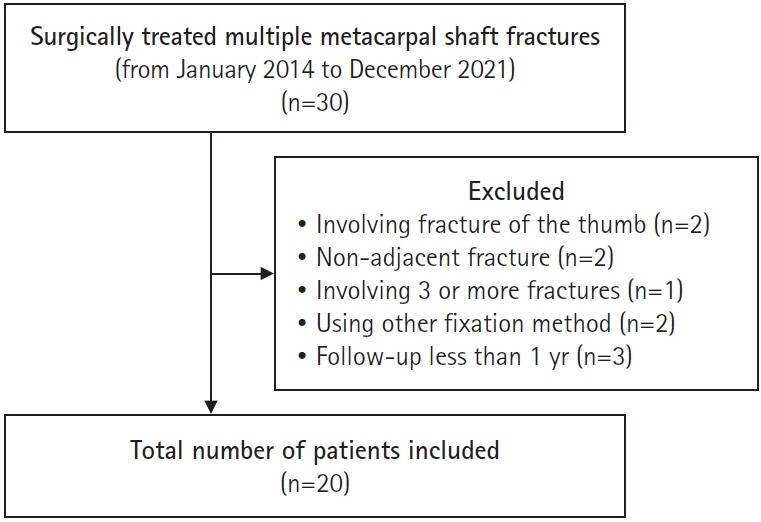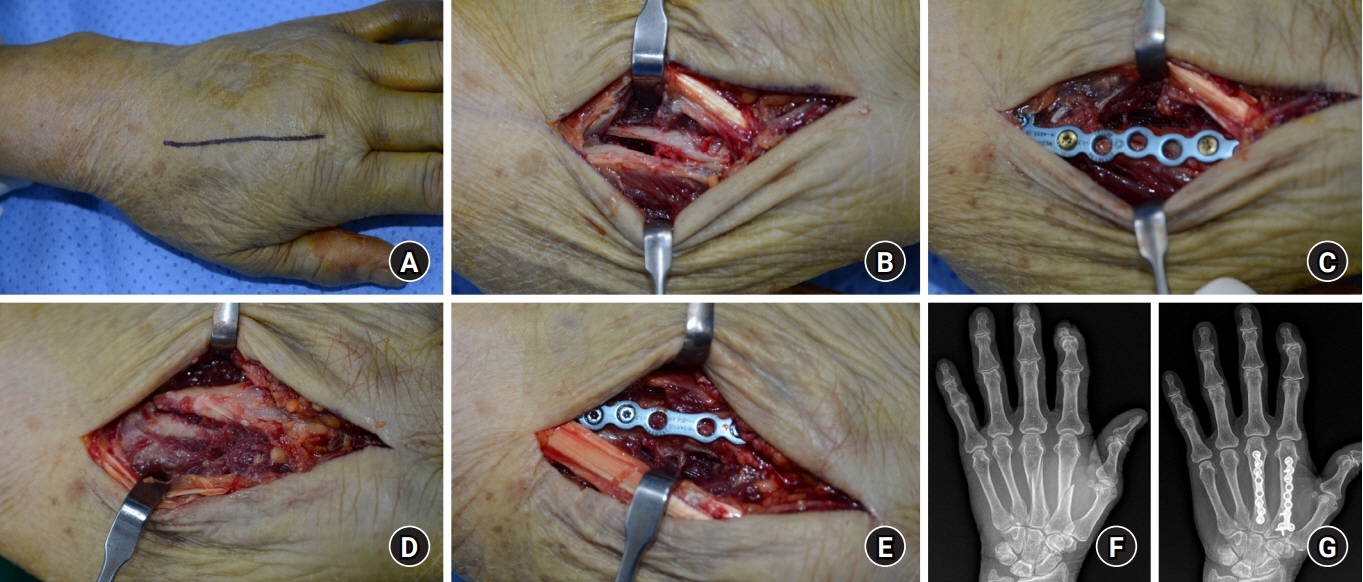Arch Hand Microsurg.
2023 Sep;28(3):150-157. 10.12790/ahm.23.0021.
Plate fixation with a single incisional approach in adjoining two metacarpal shaft fractures
- Affiliations
-
- 1Department of Orthopaedic Surgery, CHA Bundang Medical Center, Seongnam, Korea
- KMID: 2545525
- DOI: http://doi.org/10.12790/ahm.23.0021
Abstract
- Purpose
Multiple metacarpal shaft fractures are higher-energy injuries than single metacarpal shaft injuries and are considered relatively unstable because reduction is easily lost after splinting. However, few studies have been published on operative treatment because these fractures are rare. The aim of this study was to analyze the characteristics of this rare type of fracture and report the surgical outcomes.
Methods
Medical records of patients with adjacent metacarpal shaft fractures who underwent surgery were retrospectively analyzed. In total, 20 cases were included in this study. A single longitudinal incision was made at the middle of the web space of affected metacarpal bones. Fractures were fixed using a plate and screws. The clinical results were evaluated by determining the metacarpophalangeal joint range of motion, Disabilities of the Arm, Shoulder, and Hand (DASH) scores, and hand grip strength at the final follow-up.
Results
Among the patients included, there were fifteen male and five female patients. Their mean age was 41.2 years. The average range of motion of metacarpophalangeal joints was 78.1°. The average DASH score was 6.5. The average hand grip strength was 92.4% compared to the unaffected side. The mean time to union was 7.5 weeks. There were no cases of complications, such as soft tissue infections, joint stiffness, or extensor tendon injuries.
Conclusion
Plate fixation through a single incisional approach performed for adjacent metacarpal shaft fractures showed satisfactory results. This could be a recommendable approach for two unstable adjoining metacarpal shaft fractures.
Figure
Reference
-
References
1. Retrouvey H, Morzycki A, Wang AM; Canadian Plastic Surgery Research Collaborative, Binhammer P. Are we over treating hand fractures? Current practice of single metacarpal fractures. Plast Surg (Oakv). 2018; 26:148–53.
Article2. Kollitz KM, Hammert WC, Vedder NB, Huang JI. Metacarpal fractures: treatment and complications. Hand (N Y). 2014; 9:16–23.
Article3. Soni A, Gulati A, Bassi JL, Singh D, Saini UC. Outcome of closed ipsilateral metacarpal fractures treated with mini fragment plates and screws: a prospective study. J Orthop Traumatol. 2012; 13:29–33.
Article4. Souer JS, Mudgal CS. Plate fixation in closed ipsilateral multiple metacarpal fractures. J Hand Surg Eur Vol. 2008; 33:740–4.
Article5. Biz C, Iacobellis C. Comparison of percutaneous intramedullary Kirschner wire and interfragmentary screw fixation of displaced extra-articular metacarpal fractures. Acta Biomed. 2014; 85:252–64.6. Han SH, Rhee SY, Lee SC, Han SC, Cha YS. Percutaneous retrograde intramedullary single wire fixation for metacarpal shaft fracture of the little finger. Eur J Orthop Surg Traumatol. 2013; 23:883–7.
Article7. Chiu YC, Hsu CE, Ho TY, et al. Comparison of the fixation ability of headless compression screws and locking plate for metacarpal shaft transverse fracture. Medicine (Baltimore). 2021; 100:e27375.
Article8. Chiu YC, Ho TY, Ting YN, et al. Effect of oblique headless compression screw fixation for metacarpal shaft fracture: a biomechanical in vitro study. BMC Musculoskelet Disord. 2021; 22:146.
Article9. Oh JR, Kim DS, Yeom JS, Kang SK, Kim YT. A comparative study of tensile strength of three operative fixation techniques for metacarpal shaft fractures in adults: a cadaver study. Clin Orthop Surg. 2019; 11:120–5.
Article10. Vasilakis V, Sinnott CJ, Hamade M, Hamade H, Pinsky BA. Extra-articular metacarpal fractures: closed reduction and percutaneous pinning versus open reduction and internal fixation. Plast Reconstr Surg Glob Open. 2019; 7:e2261.
Article11. Dreyfuss D, Allon R, Izacson N, Hutt D. A comparison of locking plates and intramedullary pinning for fixation of metacarpal shaft fractures. Hand (N Y). 2019; 14:27–33.
Article12. Zhu X, Zhang H, Wu J, Wang S, Miao L. Pin vs plate fixation for metacarpal fractures: a meta-analysis. J Orthop Surg Res. 2020; 15:542.
Article13. Marjoua Y, Eberlin KR, Mudgal CS. Multiple displaced metacarpal fractures. J Hand Surg Am. 2015; 40:1869–70.
Article14. Eglseder WA, Juliano PJ, Roure R. Fractures of the fourth metacarpal. J Orthop Trauma. 1997; 11:441–5.
Article15. Meunier MJ, Hentzen E, Ryan M, Shin AY, Lieber RL. Predicted effects of metacarpal shortening on interosseous muscle function. J Hand Surg Am. 2004; 29:689–93.
Article16. Freeland AE, Orbay JL. Extraarticular hand fractures in adults: a review of new developments. Clin Orthop Relat Res. 2006; 445:133–45.17. Fusetti C, Garavaglia G, Papaloïzos M. Re: Souer JS, Mudgal CS. Plate fixation in closed ipsilateral multiple metacarpal fractures. J Hand Surg Eur. 2008, 33: 740-4. J Hand Surg Eur Vol. 2009; 34:560–1.
Article18. Taha RH, Grindlay D, Deshmukh S, Montgomery A, Davis TR, Karantana A. A systematic review of treatment interventions for metacarpal shaft fractures in adults. Hand (N Y). 2022; 17:869–78.
Article19. Grisdela PT, Liu DS, Dyer GS, Earp BE, Blazar P, Zhang D. Factors associated with implant removal following plate-and-screw fixation of isolated metacarpal fractures. J Hand Surg Am. 2023; 48:739.
Article
- Full Text Links
- Actions
-
Cited
- CITED
-
- Close
- Share
- Similar articles
-
- A Comparative Study of Tensile Strength of Three Operative Fixation Techniques for Metacarpal Shaft Fractures in Adults: A Cadaver Study
- Percutaneous Retrograde Intramedullary Pin Fixation for Isolated Metacarpal Shaft Fracture of the Little Finger
- Operative Treatment of Metacarpal Shaft Fracture
- Treatment of Metacarpal Shaft Fractures with Plates and Screws
- Treatment of Metacarpal Shaft Fractures with Retrograde Intramedullary Kirschner-Wire Fixation





